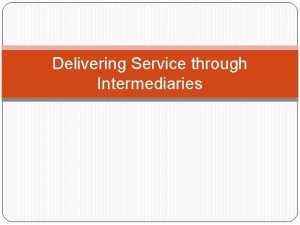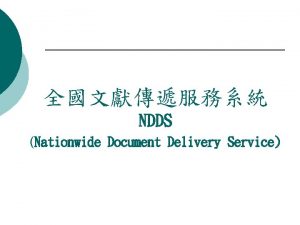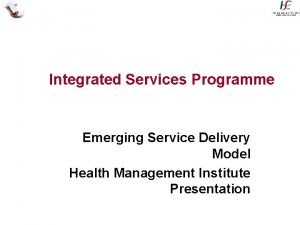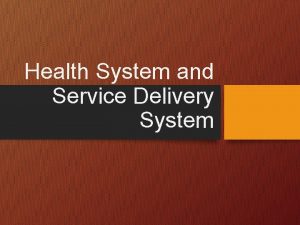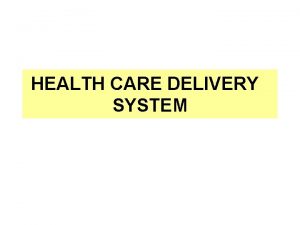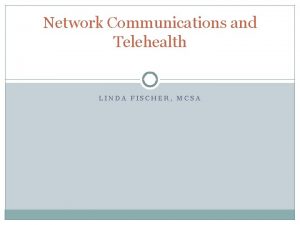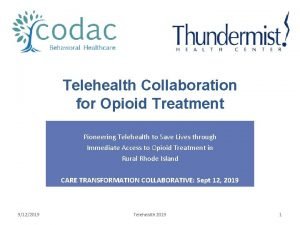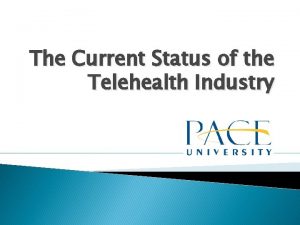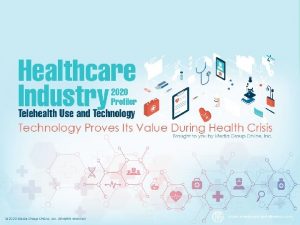TELEHEALTH THE DELIVERY OF HEALTH SERVICES AND INFORMATION















- Slides: 15

TELEHEALTH: THE DELIVERY OF HEALTH SERVICES AND INFORMATION Camille Infante National University HTM 520 June 19, 2014

WHAT IS TELEHEALTH? “Telehealth is the use of electronic information and telecommunications technologies to support longdistance clinical health care, patient and professional health-related education, public health, and health administration, ” (Health Resources and Services Administration , 2014). FYI: Telehealth vs. Telemedicine Telehealth involves a macro process of delivering healthcare through technology for preventative healthcare, healthcare promotion and curative care. Telemedicine is specific to remote curative care.

HISTORY OF TELEHEALTH Earlier traces date back to early 1900’s Modern telehealth can be dated back in 1955 in Nebraska In 2000’s, telehealth has progressed in videoconferencing between medical facilities in some rural areas; slow adoption rates The Teledactyl by Hugo Gernback in 1925.

TELEHEALTH IN THE PRESENT The Balanced Budget Act of 1997 (BBA) Not all services of telehealth are reimbursed Medicare will only pay for real-time video consultation services and Store and Forward technology; also is state specific

CLINICAL USES OF TELEHEALTH Store and Forward technology Data is captured, transmitted by sender and later retrieved by receiver Real-Time telehealth Video conferencing between patient and provider Specialty services Teletriage Data transmission via telephone; focused more on disposition of patient’s symptoms vs. clinical telehealth encounter Remote patient monitoring

CLINICAL TELEHEALTH

NON-CLINICAL USES OF TELEHEALTH Distance education Research Administrative tasks Healthcare management Patient movement/ remote admission

NON-CLINICAL TELEHEALTH

BENEFITS OF TELEHEALTH For Patients Accessibility to physicians in remote locations Specialty services can be more available Alleviation of time and transportation Reduced unnecessary appointments through remote monitoring For Physicians Extend clinical care and specialty to patients in rural areas Increased productivity through saving time from travel Accessibility to continuing medical education and research between colleagues

BARRIERS OF TELEHEALTH Lack of acceptance of patients and physicians Quality of network infrastructure and Wi-Fi capabilities Staff training Licensure and jurisdiction of physicians Lack of IT integration Continuity of care Reimbursement

TELEHEALTH AND EHR MEANINGFUL USE No explicit link between telehealth and EHR Meaningful Use Telehealth still uses paper -based medical records for documentation Information technology integration needs to be more developed

TELEHEALTH COMPANIES Teladoc Established in 2002 First and largest provider of telehealth medical consultations in the United States Serves over 7. 5 million members Services provided 24/7/365 to all members NCQA standards

TELEHEALTH COMPANIES Cisco Health. Presence Integrates high-definition video, advanced audio, third-party medical devices, and collaboration tools Each unit is staffed by an attendant trained to operate devices under the instructions of the remote health care professional

FUTURE TRENDS Telehealth as a integral part of healthcare service is expected to grow 18. 5% annually through 2018 Revenue, from 2013 to 2018, from telehealth will increase from $440. 6 million to $4. 5 billion

SUMMARY Telehealth is a macro process of using technology for healthcare Encompasses clinical and non-clinical uses Major benefits for both patient and provider Number of limitations including IT integration and reimbursement Future trends to show increase in telehealth adoption
 Telehealth and telemedicine
Telehealth and telemedicine Litweka
Litweka Ctel telehealth
Ctel telehealth Office for the advancement of telehealth
Office for the advancement of telehealth Flo telehealth
Flo telehealth Difference between health education and health promotion
Difference between health education and health promotion Features offered in adm website accenture
Features offered in adm website accenture Information discovery and delivery
Information discovery and delivery Packaging and delivery of information in advocacy
Packaging and delivery of information in advocacy Delivery of services through intermediaries
Delivery of services through intermediaries National wide document delivery services
National wide document delivery services Integrated services delivery
Integrated services delivery It service delivery objectives
It service delivery objectives Health and social component 3
Health and social component 3 Introduction of health care delivery system
Introduction of health care delivery system Health service delivery network
Health service delivery network









